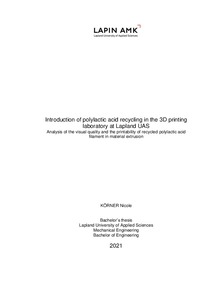Introduction of polylactic acid recycling in the 3D printing laboratory at Lapland UAS
Körner, Nicole (2021)
Körner, Nicole
2021
All rights reserved. This publication is copyrighted. You may download, display and print it for Your own personal use. Commercial use is prohibited.
Julkaisun pysyvä osoite on
https://urn.fi/URN:NBN:fi:amk-202105189133
https://urn.fi/URN:NBN:fi:amk-202105189133
Tiivistelmä
FDM is well known in engineering for its ability to produce prototypes quickly and cost-effectively. However, what exactly happens to the prototypes that are not needed is not yet sufficiently discussed. The 3D printing lab at Lapland University of Applied Sciences also produces many unneeded prototypes, especially from the material polylactic acid (PLA). In order to be able to reuse this material, a polymer shredder, a polymer dryer and a filament extruder were purchased from the company 3devo. The aim of this work was to examine these devices and to find the right settings for a successful application in the lab.
For this purpose, a literature research was carried out first. Then the devices were set-up and examined through initial tests. Using different mixing ratios of virgin PLA granules and recycled PLA waste material (0 % - 100 % recycled PLA material) from the laboratory, suitable setting profiles for the individual process steps (preparation, extrusion and printing) were determined. Finally, the environmental impact and advantages and disadvantages of material recycling in the 3D printing lab were discussed.
The results of these tests showed that it is possible to produce filament for material extrusion with every mixture investigated and that this filament can be used for the production of further prototypes and objects. The discussion showed that the introduction of the devices support the step towards a circular economy in the lab. Furthermore, these devices also offer students and teachers the opportunity to get to know the topic of polymer recycling in a practical way.
For this purpose, a literature research was carried out first. Then the devices were set-up and examined through initial tests. Using different mixing ratios of virgin PLA granules and recycled PLA waste material (0 % - 100 % recycled PLA material) from the laboratory, suitable setting profiles for the individual process steps (preparation, extrusion and printing) were determined. Finally, the environmental impact and advantages and disadvantages of material recycling in the 3D printing lab were discussed.
The results of these tests showed that it is possible to produce filament for material extrusion with every mixture investigated and that this filament can be used for the production of further prototypes and objects. The discussion showed that the introduction of the devices support the step towards a circular economy in the lab. Furthermore, these devices also offer students and teachers the opportunity to get to know the topic of polymer recycling in a practical way.
